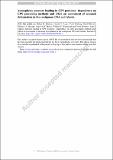| dc.contributor.author | Herring, Thomas A | |
| dc.date.accessioned | 2021-02-24T19:49:37Z | |
| dc.date.available | 2021-02-24T19:49:37Z | |
| dc.date.issued | 2020-11-18 | |
| dc.identifier.issn | 0949-7714 | |
| dc.identifier.uri | https://hdl.handle.net/1721.1/129994 | |
| dc.description.abstract | The Global Positioning System (GPS) has revolutionized the ability to monitor Earth-system processes, including Earth’s water cycle. Several analysis centers process GPS data to estimate ground-antenna positions at daily temporal resolution. Differences in processing strategies can lead to inconsistencies in coordinate-position estimates and therefore influence the analysis of crustal displacement associated with variations in atmospheric and hydrologic mass loading. Here, we compare five GPS data products produced by three processing centers: the Nevada Geodetic Laboratory, Jet Propulsion Laboratory, and UNAVCO Consortium. We find that 5 to 30% of the scatter in residual GPS time series (commonly considered noise) can be explained by atmospheric loading in the contiguous USA and Alaska, but that the percentages vary widely by data product. Positions derived using high-resolution troposphere models (e.g., ECMWF) exhibit significantly lower scatter after correcting for atmospheric loading than positions estimated using constant or slowly varying troposphere models (e.g., GPT2w). The data products also exhibit differences in seasonal deformation (commonly attributed, in large part, to fluctuations in hydrologic mass loading): median vector differences in estimated seasonal amplitude range from 0.4–1.0 mm in the vertical component and 0.1–0.3 mm in the horizontal components, or about 10–40% of the mean amplitudes of seasonal oscillation. Newer products exhibit lower total scatter and stronger correlations than older products. Network-coherent differences in estimates of seasonal deformation reveal reference-frame inconsistencies between data products. We also cross-check two independent models of atmospheric pressure loading: ESMGFZ and LoadDef. | en_US |
| dc.description.sponsorship | United States. National Aeronautics and Space Administration. Global Navigation Satellite Systems. Remote Sensing Science Team (Grant NNH14ZDA001N-GNSS) | en_US |
| dc.publisher | Springer Berlin Heidelberg | en_US |
| dc.relation.isversionof | https://doi.org/10.1007/s00190-020-01445-w | en_US |
| dc.rights | Creative Commons Attribution-Noncommercial-Share Alike | en_US |
| dc.rights.uri | http://creativecommons.org/licenses/by-nc-sa/4.0/ | en_US |
| dc.source | Springer Berlin Heidelberg | en_US |
| dc.title | Atmospheric pressure loading in GPS positions: dependency on GPS processing methods and effect on assessment of seasonal deformation in the contiguous USA and Alaska | en_US |
| dc.type | Article | en_US |
| dc.identifier.citation | Martens, Hilary R. et al. “Atmospheric pressure loading in GPS positions: dependency on GPS processing methods and effect on assessment of seasonal deformation in the contiguous USA and Alaska.” Journal of Geodesy, 94 (November 2020): 115 © 2020 The Author(s) | en_US |
| dc.contributor.department | Massachusetts Institute of Technology. Department of Earth, Atmospheric, and Planetary Sciences | en_US |
| dc.relation.journal | Journal of geodesy | en_US |
| dc.eprint.version | Author's final manuscript | en_US |
| dc.type.uri | http://purl.org/eprint/type/JournalArticle | en_US |
| eprint.status | http://purl.org/eprint/status/PeerReviewed | en_US |
| dc.date.updated | 2020-12-05T04:24:58Z | |
| dc.language.rfc3066 | en | |
| dc.rights.holder | Springer-Verlag GmbH Germany, part of Springer Nature | |
| dspace.embargo.terms | Y | |
| dspace.date.submission | 2020-12-05T04:24:58Z | |
| mit.journal.volume | 94 | en_US |
| mit.license | OPEN_ACCESS_POLICY | |
| mit.metadata.status | Complete | |
